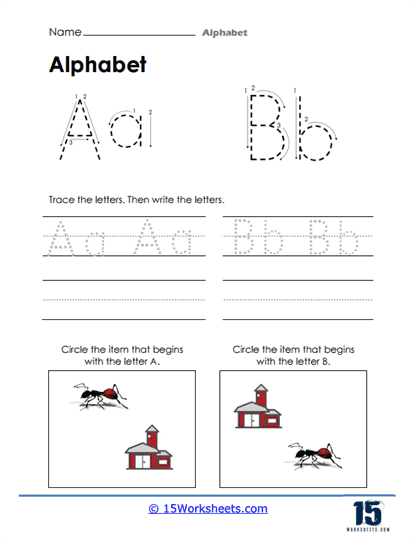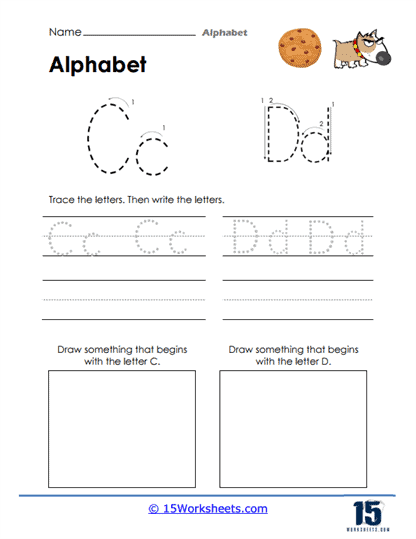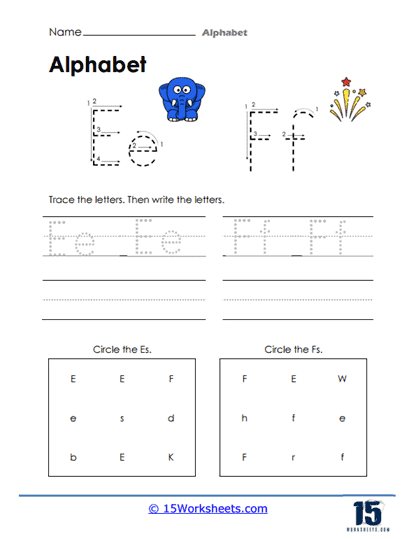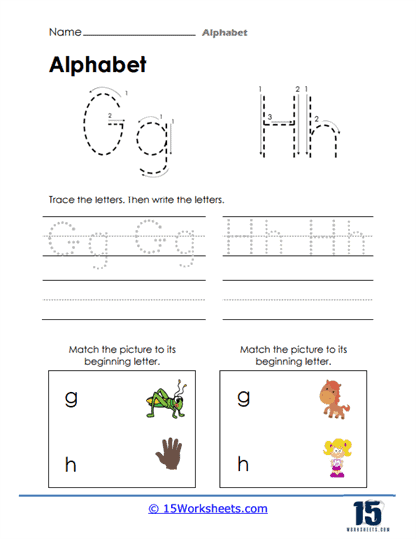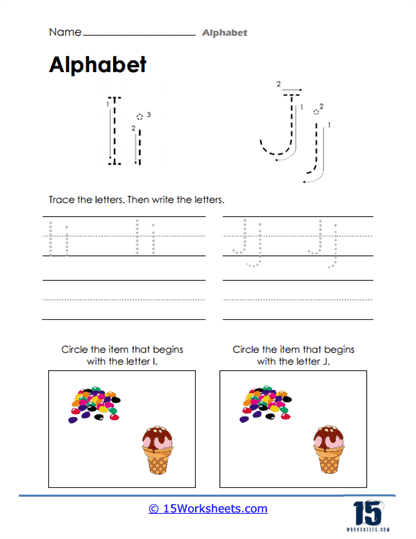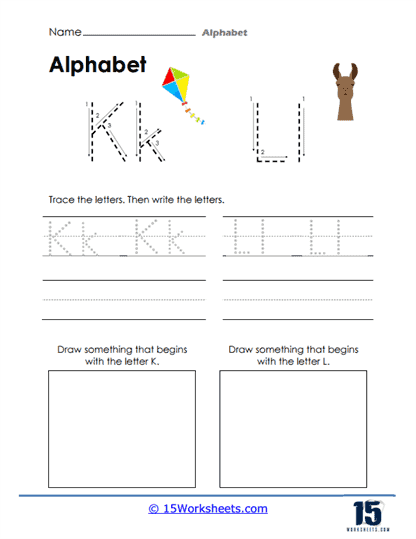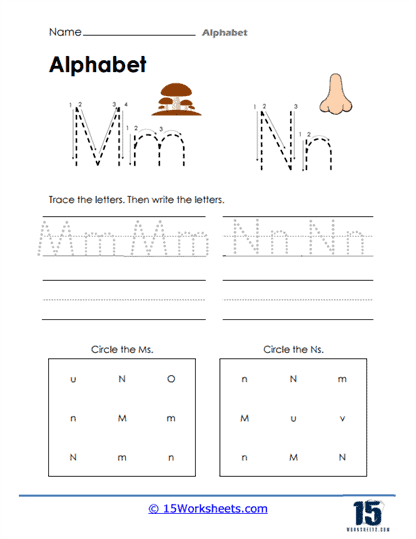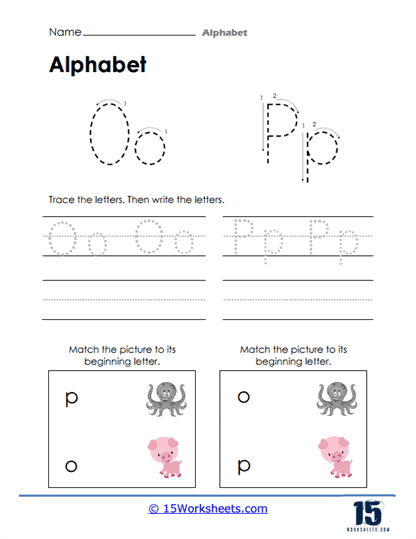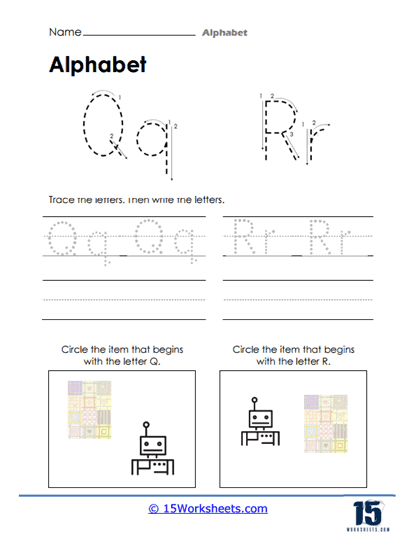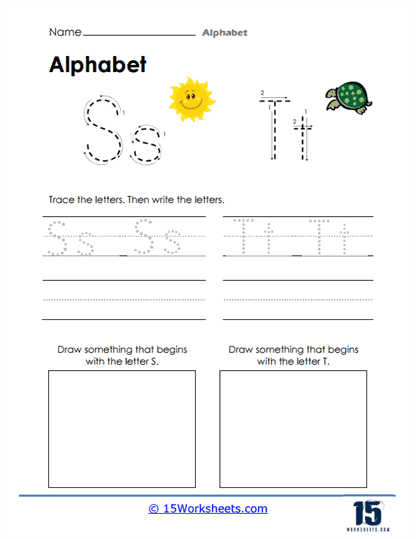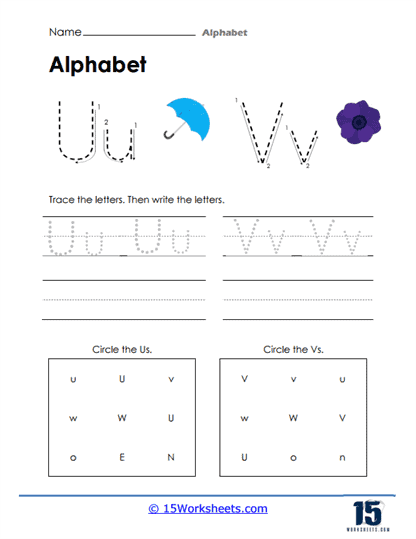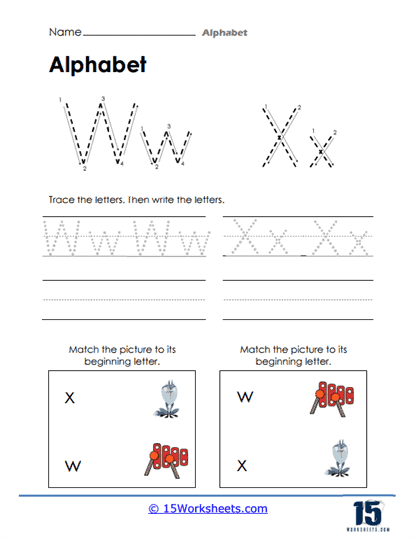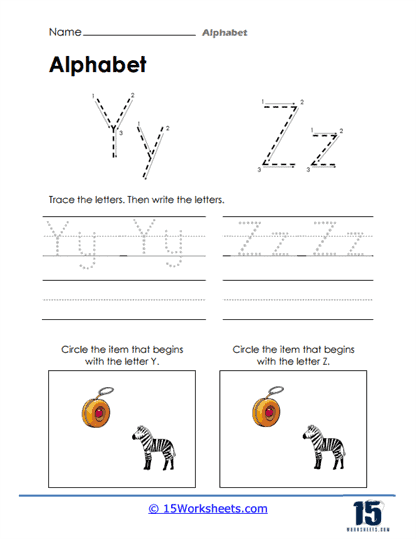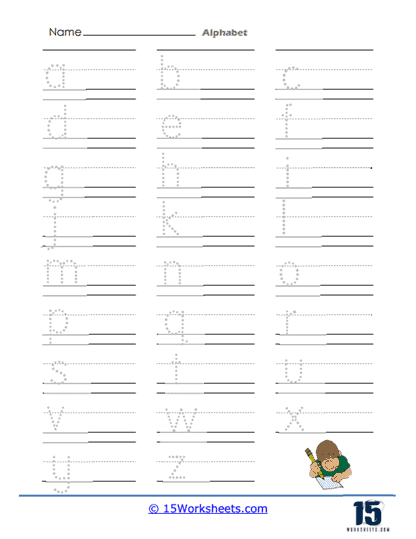Alphabet Worksheets
About These 15 Worksheets
Alphabet worksheets are educational activities designed to help children learn and practice the alphabet, including letter recognition, letter formation, and basic phonics skills. These worksheets come in various formats, including tracing and writing letters, identifying letters and their sounds, matching uppercase and lowercase letters, and more.
Alphabet worksheets can come in various formats, such as:
Tracing and Writing – Worksheets may require children to trace and write individual letters or groups of letters to develop fine motor skills and letter formation.
Letter Identification – Children may need to identify and circle specific letters or find all the occurrences of a given letter within a word or sentence.
Phonics and Letter Sounds – Worksheets could require children to match pictures with the corresponding initial letter sound or identify the letter sound in given words.
Matching and Sorting – Children may be asked to match uppercase and lowercase letters or sort letters by specific criteria, such as by color or by letter formation.
How These Worksheets Help Students
Alphabet worksheets offer several benefits for children:
Letter Recognition – Learning the alphabet helps children recognize and identify letters, which is essential for reading and writing. They feature large, clear letter designs that make it easier for young learners to recognize and differentiate between letters.
Phonics – Practicing letter sounds and phonics activities helps children develop basic reading skills, including phonemic awareness and decoding. For example, children may be asked to match pictures with the initial letter sound or complete words using the correct beginning sound.
Writing and Fine Motor Skills – Tracing and writing letters helps develop fine motor skills, hand-eye coordination, and letter formation. These exercises allow children to practice the correct strokes and movement patterns needed to write each letter accurately.
Vocabulary Development – Alphabet worksheets that incorporate pictures or words can help expand children’s vocabulary and improve their language skills.
Foundation for Learning – Practicing alphabet worksheets is essential for building a strong foundation in literacy skills, which are crucial for children’s success in various academic subjects.
These worksheets can play a valuable role in early literacy education by providing a systematic and interactive approach to learning the alphabet. They offer a range of activities that cater to different learning styles and allow children to develop crucial skills necessary for reading and writing.
7 Different Strategies For Introducing Kids to the Alphabet
Teaching children the letters of the alphabet can be approached through various interactive and engaging methods. Here are several different ways to introduce and reinforce alphabet learning:
1. Alphabet Books
Alphabet books are a staple in teaching letters. These books typically have a letter on each page, accompanied by an image of an object that starts with that letter. Reading alphabet books with children allows them to see the letter, say the name, and hear the sound it makes, linking the visual letter with its phonetic sound.
2. Alphabet Songs
Songs such as the classic “ABC song” are memorable and can help children learn the sequence of the alphabet. Singing is a fun activity that can be done anywhere, and many variations of alphabet songs exist that also incorporate the sounds each letter makes.
3. Letter Crafts
Crafts that involve creating letters using paper, glue, scissors, and other materials allow children to work with the shapes of letters in a tactile way. This hands-on activity can be extended to include objects that start with the letter they are creating, such as gluing cotton balls onto a paper “C” when learning the word “cloud.”
4. Alphabet Flashcards
Flashcards with letters and corresponding pictures can be a visual cue for children. Showing the card and saying the letter and its sound helps reinforce their connection. Flashcards can be used for a variety of games and activities that make learning fun.
5. Educational Technology
Interactive apps and computer games offer another avenue for learning the alphabet. These technologies can provide immediate feedback and often include games that match letters with sounds, which is appealing to many children.
6. Environmental Print
Pointing out and reading letters in the environment, such as on signs, labels, and packaging, helps children realize that letters are everywhere and have meaning. This method also contextualizes the letters and sounds in everyday life.
7. Alphabet Puzzles
Puzzles that require matching letters with pictures or letters with other letters (uppercase with lowercase) are an excellent way to teach the alphabet. As children handle the pieces, they become familiar with the shape and feel of each letter.
How Do You Teach the Sounds They Make?
To teach the sound that each letter makes, educators often use phonics, a method that involves teaching children to connect sounds with the corresponding letters. Here’s how educators might introduce phonetic sounds:
1. Isolation of Sounds
Begin with isolating the sound each letter makes. Emphasize the sound clearly and repeatedly while showing the letter to help children make the connection.
2. Repetition and Rhyme
Using nursery rhymes and poems can highlight specific sounds. Repeating these sounds helps children recognize and produce them.
3. Association with Words
Associating the sound with a word that starts with the letter being taught can be very helpful. For example, saying “D is for dog, /d/, /d/, dog,” children hear the sound in context.
4. Sound Matching Activities
Activities like finding objects that start with a certain sound or sorting pictures based on initial sounds can be very effective. This not only reinforces the sound but also helps with listening skills.
5. Manipulation of Sounds
Changing the first letter of familiar words to create new words is a playful way to teach letter sounds. For example, changing the “m” in “mat” to “b” to make “bat” can be a fun exercise for children to hear the difference the initial letter makes.
These methods of teaching the alphabet and phonics can be adapted to suit individual children’s learning styles and can be made more complex as their understanding grows. The key to success is making the learning process fun, interactive, and a regular part of the child’s world.

